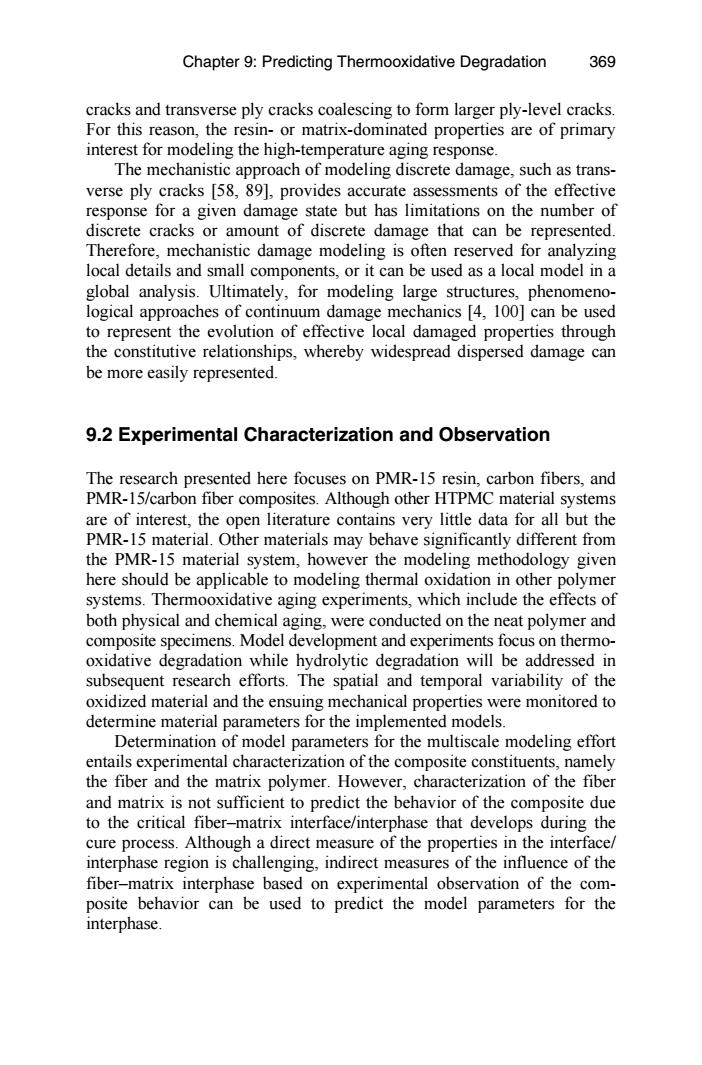正在加载图片...

Chapter 9:Predicting Thermooxidative Degradation 369 cracks and transverse ply cracks coalescing to form larger ply-level cracks. For this reason,the resin-or matrix-dominated properties are of primary interest for modeling the high-temperature aging response. The mechanistic approach of modeling discrete damage,such as trans- verse ply cracks [58,89],provides accurate assessments of the effective response for a given damage state but has limitations on the number of discrete cracks or amount of discrete damage that can be represented. Therefore,mechanistic damage modeling is often reserved for analyzing local details and small components,or it can be used as a local model in a global analysis.Ultimately,for modeling large structures,phenomeno- logical approaches of continuum damage mechanics [4,100]can be used to represent the evolution of effective local damaged properties through the constitutive relationships,whereby widespread dispersed damage can be more easily represented. 9.2 Experimental Characterization and Observation The research presented here focuses on PMR-15 resin,carbon fibers,and PMR-15/carbon fiber composites.Although other HTPMC material systems are of interest,the open literature contains very little data for all but the PMR-15 material.Other materials may behave significantly different from the PMR-15 material system,however the modeling methodology given here should be applicable to modeling thermal oxidation in other polymer systems.Thermooxidative aging experiments,which include the effects of both physical and chemical aging,were conducted on the neat polymer and composite specimens.Model development and experiments focus on thermo- oxidative degradation while hydrolytic degradation will be addressed in subsequent research efforts.The spatial and temporal variability of the oxidized material and the ensuing mechanical properties were monitored to determine material parameters for the implemented models. Determination of model parameters for the multiscale modeling effort entails experimental characterization of the composite constituents,namely the fiber and the matrix polymer.However,characterization of the fiber and matrix is not sufficient to predict the behavior of the composite due to the critical fiber-matrix interface/interphase that develops during the cure process.Although a direct measure of the properties in the interface/ interphase region is challenging,indirect measures of the influence of the fiber-matrix interphase based on experimental observation of the com- posite behavior can be used to predict the model parameters for the interphase.cracks and transverse ply cracks coalescing to form larger ply-level cracks. For this reason, the resin- or matrix-dominated properties are of primary interest for modeling the high-temperature aging response. The mechanistic approach of modeling discrete damage, such as transverse ply cracks [58, 89], provides accurate assessments of the effective response for a given damage state but has limitations on the number of discrete cracks or amount of discrete damage that can be represented. Therefore, mechanistic damage modeling is often reserved for analyzing local details and small components, or it can be used as a local model in a global analysis. Ultimately, for modeling large structures, phenomenological approaches of continuum damage mechanics [4, 100] can be used to represent the evolution of effective local damaged properties through the constitutive relationships, whereby widespread dispersed damage can be more easily represented. 9.2 Experimental Characterization and Observation The research presented here focuses on PMR-15 resin, carbon fibers, and PMR-15/carbon fiber composites. Although other HTPMC material systems are of interest, the open literature contains very little data for all but the PMR-15 material. Other materials may behave significantly different from the PMR-15 material system, however the modeling methodology given here should be applicable to modeling thermal oxidation in other polymer systems. Thermooxidative aging experiments, which include the effects of both physical and chemical aging, were conducted on the neat polymer and composite specimens. Model development and experiments focus on thermooxidative degradation while hydrolytic degradation will be addressed in subsequent research efforts. The spatial and temporal variability of the oxidized material and the ensuing mechanical properties were monitored to determine material parameters for the implemented models. Determination of model parameters for the multiscale modeling effort entails experimental characterization of the composite constituents, namely the fiber and the matrix polymer. However, characterization of the fiber and matrix is not sufficient to predict the behavior of the composite due to the critical fiber–matrix interface/interphase that develops during the cure process. Although a direct measure of the properties in the interface/ interphase region is challenging, indirect measures of the influence of the fiber–matrix interphase based on experimental observation of the composite behavior can be used to predict the model parameters for the interphase. Chapter 9: Predicting Thermooxidative Degradation 369